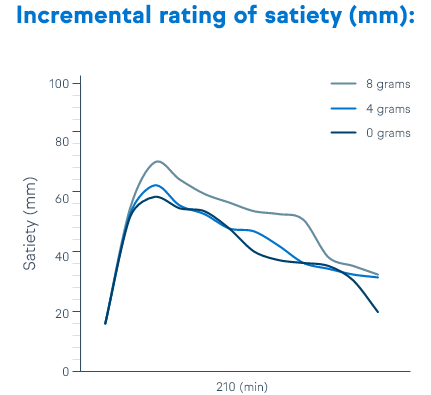Effect of fenugreek fiber on satiety, blood glucose and insulin response and energy intake in obese subjects
Mathern, JR, Raatz SK, Thomas W, Slavin JL , Department of Food Science and Nutrition, University of Minnesota, St Paul, MN USA., 2008
Overview
Many areas of the world are increasingly faced with an obesity epidemic, with obesity defined as having a Body Mass Index (BMI) over 30. While total energy and fat intake play key roles in the development and treatment of obesity, observational studies have shown that dietary fiber intake is inversely associated with BMI, that obese individuals consume significantly less fiber than lean individuals and that they are more responsive to fiber interventions. Fiber promotes satiety and thereby reduces energy intake. The following randomized crossover study shows that consuming fiber from FenuLife increases satiety and promotes reduced energy intake in obese individuals
Results & discussion
For measurements of satiety, hunger, fullness and prospective food consumption, the 8 g dosage of FenuLife was significantly different than the other treatment options. Satiety and fullness measurements, both peak and area under-the-curve (AUC) were higher, and hunger and prospective food consumption measurements lower. There was no statistical difference between the 4 g dosage and the control (Figure 1). The presence of the viscous fiber from fenugreek may have played a role in promoting satiety by slowing the rates of gastric emptying. Energy intake at a lunch buffet tended (p=0.11) to be approximately 100 Kcal less for the 8 g group, while there was no significant difference between 0 and 4 g, and there was no difference in energy consumption for the rest of the day between the treatments (Table 1). This indicates that the satiety effects of FenuLife are short-term. Postprandial glucose and insulin responses were not statistically different except for the insulin response of the 8 g dosage of FenuLife. The increase in satiety in this study was not related to reduced glucose absorption.
Conclusion
This clinical trial demonstrates that an 8 g dosage of FenuLife added to breakfast significantly increases reported satiety in obese patients. Individuals experienced higher levels of satiety and fullness and reduced hunger and prospective food consumption. This study did not provide evidence of beneficial effects on carbohydrate metabolism. This could be due to the small meal size at breakfast, as a previous study found that 8 g FenuLife significantly reduced glucose AUC response to a glucose drink. The effects on appetite suppression and food intake suggest that FenuLife can be an effective ingredient in weight management and slimming formulations.
Energy intake in response to different treatments
| Treatments | F-Test | |||
|---|---|---|---|---|
| Measurement | 0 gr | 4 gr | 8 gr | P value |
| Calories eat ad libitum lunch (Kcal) | 1285±98 | 1352±98 | 1157±98 | 0.05 |
| Calories eaten rest of study day (Kcal) | 1057±150 | 1266±142 | 1171±142 | 0.48 |
Mathern et al. (2009). “Effect of fenugreek fiber on satiety,
blood glucose and insulin response and energy intake in
obese subjects.” Phytotherapy Research 23(11): 1543-1548.
Study design
18 obese (BMI 36±5), but otherwise healthy men and women (age 32 ± 11) consumed a beverage with either 0 grams (control), 4 grams or 8 grams of FenuLife, followed by standardized low fiber breakfast consisting of cereal, white bread, butter and jelly (355 Kcal, 12 g protein, 5 g fat and 6 g). carbohydrate). The meals were identical, with as only variable the amount of fiber provided by FenuLife, which is 90% total fiber by weight and >75% soluble fiber. Ratings of satiety, hunger, fullness and prospective food consumption were assessed using visual analog scales (VAS) at 30 minute intervals from the start of breakfast for 3.5 hours. Blood was collected at 15 minute (first hour) and then 30 minute intervals for 3 hours to measure glucose and insulin levels. 3.5 hours after breakfast, participants consumed an ad libitu lunch buffet, where energy intake was measured. Participants recorded food consumed for the remainder of the day.




